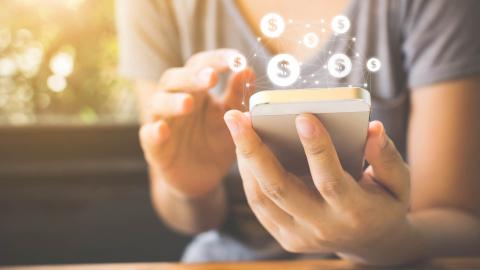
Q:What are some effective ways to market paperless billing in terms of timing, behavioral tactics, and bundling with related offerings?
A:Behavior-change themes should be integrated into any paperless billing marketing strategy.
Market research by at least three utilities, including BC Hydro, Entergy, and Union Gas, found that customers don’t switch to paperless billing because their paper bills serve as reminders to pay.
Bill notifications (via text or email) can remove that perceived barrier. BC Hydro’s research found that adding bill reminders via email with the bill amount due and due date reduced customers’ uneasiness around letting go of their hard-copy bills.
We recommend marketing billing alerts and notifications with your paperless billing advertisements. Salt River Project, for example, took a simple approach to this (figure 1).
Figure 1: Marketing notifications with paperless billing
The contact center can also be a great avenue through which you can boost participation in paperless billing.
During complaint calls, outages, and other high-call-volume periods, you should avoid advertising self-service programs such as e-billing. But during interactions such as payment-related calls and phone requests to start new service, you can introduce paperless billing options with some success.
Start-service is an opportune moment in the customer journey to promote paperless billing because new customers are interested in the value their new utility can provide. They’re also more open to changing their habits. BC Hydro has been using start-service calls to promote paperless billing since 2011 and has seen sustained success of over 40 percent conversion rates.
After you get your contact center on board with a paperless billing promotional plan, consider using internal contests to encourage call center agents to compete for e-billing “sales.” This can be an effective way to boost enrollment while keeping agents engaged.
Marketing autopay and level pay
Marketing additional online payment offerings or services should complement paperless billing marketing efforts. Autopay and level pay are examples of ways to alleviate customers’ hesitations for enrolling in paperless billing.
Otter Tail Power Co.’s e-bill program, called ePay, goes beyond turning off the paper bill by including the options to choose a due date and make free automatic payments. The program also features SMS and email bill reminders. By bundling these common billing and payment offerings, the message is clear to customers that turning off their paper bills comes with an easier billing and payment experience.
To strengthen the value proposition, consider making certain billing and payment features—such as text alerts—only available to paperless billing customers as a way to motivate the changeover.
Seasonal marketing
We aren’t aware of a time of year when it’s more effective to market paperless billing than other times. What we’ve seen, however, are utilities playing on cultural nuances during seasons, holidays, and sporting events to market paperless billing (figure 2).
Figure 2: Cultural marketing of paperless billing







